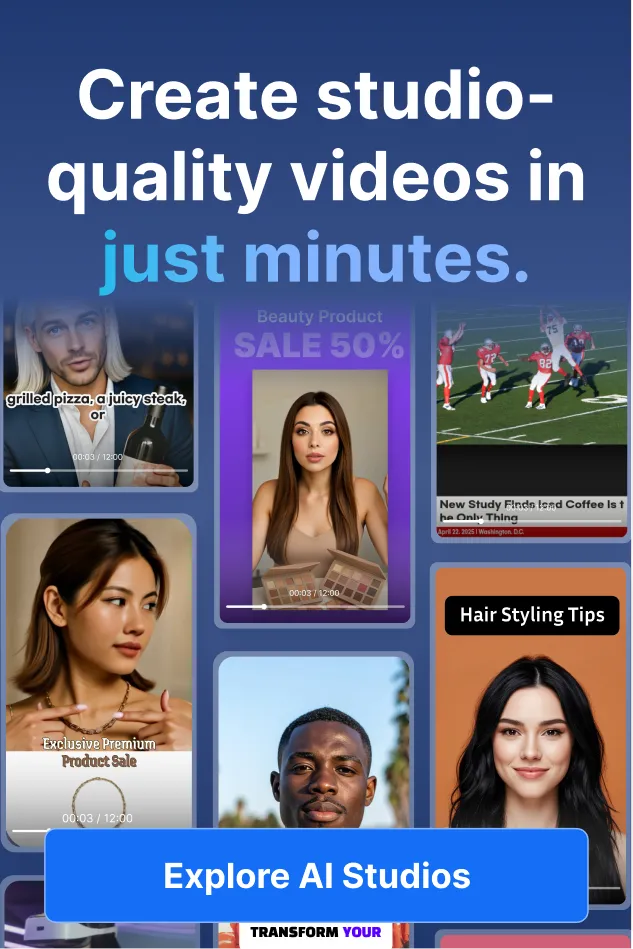What are AI Avatar Generators?
AI avatar generators are platforms that use artificial intelligence to create digital characters that represent a person or persona. Instead of needing advanced design or animation skills, users can simply upload a photo or video, enter text, or adjust settings to generate an avatar. These avatars can be realistic and human-like, stylized like cartoons or anime, or even entirely imaginative characters.
Traditionally, building an avatar required complex software and expertise in 3D modeling or animation. Today, AI has changed that. With just a few clicks, anyone can design and personalize an avatar that reflects their identity, personality, or brand. These avatars are widely used across social media, gaming, virtual events, marketing, and professional communication, making them a versatile tool in both personal and business settings.
Key Characteristics of AI Avatars
- Script-to-Speech Delivery: Just type out a script and the avatar will read it aloud, moving its lips in sync so it feels like you’re watching a real person speak.
- Lifelike Facial Expressions: Modern avatars can smile, nod, raise their eyebrows, and show a range of emotions, which makes interactions feel much more natural.
- Natural Body Movements: Instead of looking stiff or robotic, avatars now include gestures and subtle movements that make them feel more alive and engaging.
- Multilingual Voice Options: Many avatars can speak in different languages and accents, with natural pacing and tone, making them great for global audiences.
- Customizable Appearance: You can design an avatar to look like yourself, a coworker, or even create a completely new character from scratch.
- Scalable and Versatile: Once you’ve created an avatar, you can use it across all kinds of projects, videos, presentations, games, or training content, without having to film anything.
As AI continues to advance, avatar generators are becoming more accessible, powerful, and customizable. Whether you want a lifelike digital twin for professional presentations or a creative character for entertainment, AI avatar generator platforms give you a wide range of options to enhance how you connect and communicate online.
What are the different types of AI Avatars?
AI avatars are available in different forms, each designed for specific uses. Knowing the main types helps you choose the right one for your goals, whether that is marketing, education, entertainment, or customer interaction.
- Photorealistic Avatars: These avatars are built to look just like real people, sometimes even modeled after specific individuals. They’re often used in professional settings like training videos, corporate communications, or customer service, where a lifelike presence helps build trust.
- Cartoon or Stylized Avatars: Not every avatar needs to be realistic. Some are designed with bold, exaggerated, or artistic styles, making them popular for gaming, social media, and creative projects. Think anime-inspired characters, mascots, or playful digital personas that give brands a unique personality.
- 3D Animated Avatars: Created with full 3D modeling, these avatars move with more dynamic body language and can be shown from different angles. They’re especially common in video games, VR, and metaverse spaces, where immersion and movement are essential.
- Product Avatars: A newer trend is avatars that can wear, hold, or interact with products naturally. Imagine an avatar trying on virtual clothing, demonstrating a gadget, or showcasing accessories in a lifelike way. This makes them especially useful for e-commerce and digital marketing.
- Voice-Only Avatars: Some avatars don’t need a face at all. Voice-only avatars focus entirely on speech and tone, making them a fit for smart assistants, call centers, and interactive audio platforms where a visual presence isn’t required.
- Virtual Influencers: These are AI-powered digital personalities designed to act like influencers. They have their own style, voice, and online presence, often building a following on social media. Brands use them for campaigns, product endorsements, and storytelling.
- Interactive Avatars: Unlike pre-recorded avatars, interactive ones can respond in real time. They answer questions, guide users, or even host live events. This makes them a strong choice for customer support, education, and virtual conferences where engagement matters.
Use Cases for AI Avatar Generators
AI avatar generators are versatile tools, and their applications keep expanding as the technology improves. Here are some of the most common ways they are used today:
- Business Presentations and Corporate Communication: Companies create avatars to deliver executive messages, onboarding videos, and internal training content without the need for filming or editing.
- E-Learning and Training: Educators and organizations design avatars for training modules that explain complex topics, speak in multiple languages, and connect with global learners.
- Marketing and Advertising: Brands use avatars for product demos, ads, and explainer videos that can be produced quickly and tailored for different audiences.
- Social Media and Influencers: Creators develop avatars for YouTube, TikTok, and Instagram content. Some even launch fully virtual influencers powered by AI.
- Gaming and Virtual Worlds: Stylized or 3D avatars enhance immersion in games, VR platforms, and metaverse experiences where players or brands want a unique digital identity.
- Customer Service and Virtual Assistants: Interactive avatars greet customers on websites, answer common questions, and guide users through processes in real time.
- Personal Use: Individuals design avatars for fun, whether to create a digital twin, experiment with anime-style characters, or generate unique profile pictures.
Benefits of Using an AI Avatar Generator
AI avatar makers provide clear advantages for both individuals and businesses. They save time, reduce costs, and make it simple to create professional, engaging content. Here are some of the key benefits:
- Saves Time and Resources: You can produce high-quality videos and digital content without cameras, studios, or actors, which reduces both production time and costs.
- Easy to Use: Most platforms are beginner-friendly, allowing anyone to create avatars with just a few clicks instead of needing design or animation skills.
- Customizable and Flexible: Avatars can be tailored to match your brand, personality, or creative vision, whether you want a realistic spokesperson or a stylized character.
- Supports Global Communication: Many AI avatars can speak in multiple languages and accents, making it simple to localize content for international audiences.
- Scalable for Any Purpose: Once created, an avatar can be reused across different projects such as training modules, marketing campaigns, and social media content.
Top 10 Video AI Avatar Generators for 2025
Choosing the right custom AI avatar generator can make a big difference in how you bring your digital personas to life. The tool you pick will affect realism, ease of use, cost, and flexibility. Here are some of the leading AI avatar platforms to explore in 2025:
1. AI STUDIOS by DeepBrain AI
AI STUDIO is a powerful AI avatar generation platform that allows users to create ultra-realistic digital avatars and turn written scripts into professional-quality videos with synchronized speech and emotion. The platform is designed for scalability, supporting everything from individual creators to large enterprises.
It offers multiple methods of custom avatar generation, including Custom Avatars created from user video uploads, Photo Avatars for quick, image-based creation, Product Avatars that bring branded assets or characters to life, and Enterprise-Grade Custom Avatars filmed in-studio or generated in 3D for the highest level of realism and control. This range makes AI Studios highly adaptable for marketing, education, product demos, and training applications.

Key Features
- Realistic Avatars: Provides access to over 2,000 AI avatars, along with several custom avatar creation options, including photo-based, product-specific, and enterprise-level avatars with natural movements and facial expressions.
- Script-to-Video Conversion: Converts written scripts directly into videos with avatars that perform natural speech, gestures, and transitions for a polished, human-like presentation.
- Multilingual Dubbing & Voice Cloning: Supports over 150 languages with advanced voice cloning for localized content and precise lip synchronization.
- Collaborative Editing & Templates: Features a browser-based video editor with ready-made templates, brand asset management, and multi-user collaboration for efficient production workflows.
Strengths
AI STUDIO automates much of the video production process, making it possible to generate high-quality, multilingual videos without specialized editing skills. It’s user-friendly yet powerful, offering flexibility for creators while maintaining enterprise-grade reliability. Its customizable avatar system and multilingual capabilities make it especially effective for companies producing content across global markets. The platform also supports 4K video exports, batch rendering, and team collaboration, helping organizations scale content creation efficiently.
Limitations
Some advanced features, including premium avatar options and watermark-free videos, are available only through paid tiers. Rendering times can increase with complex avatars or longer videos, especially during peak hours. While avatars look highly realistic, nuanced emotional expression and complex physical interaction are still being refined. The platform is best suited for marketing, training, and communication content rather than cinematic or purely creative filmmaking.
2. Sora 2
Sora AI is an advanced generative video platform that allows users to create ultra-realistic, short-form videos using custom digital avatars called Caemos. Designed as a social media-style app, Sora enables users to produce 10-second clips from text prompts, using either their own Caemo or avatars shared by others. Its underlying model, Sora 2, delivers groundbreaking realism in physics, lighting, and natural human motion—creating short clips that feel filmed in the real world. Combined with its dynamic audio generation and integrated sound effects, Sora AI offers a new level of immersion for AI-generated video content.
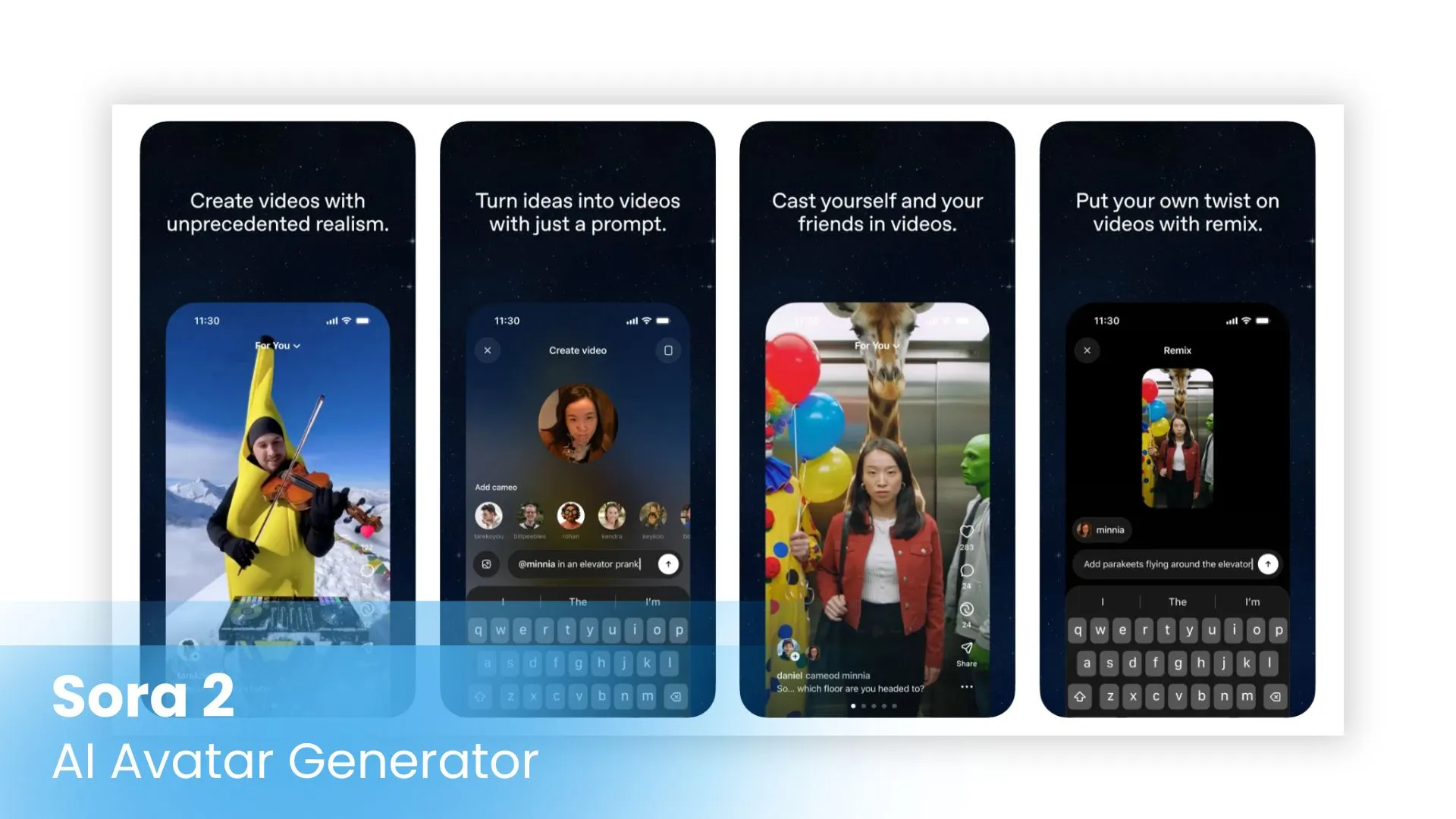
Key Features
- Exceptionally Realistic Generation: Sora 2 delivers best-in-class video realism, accurately simulating physical interactions, environmental effects, and multi-character motion directly from a text prompt.
- Caemo Avatar System: Users can create personalized Caemos by recording a short video or audio clip that captures their likeness and voice. These avatars can be shared or used by others to generate new clips.
- Cinematic Audio and Voice: Includes synchronized voice generation, dialogue, and ambient sound effects, all blended seamlessly for lifelike audio experiences without post-production editing.
- Creative Prompt Control: Responds dynamically to natural language prompts, supporting multiple artistic styles—from cinematic realism to anime-inspired storytelling.
- Social Creation Platform: Functions as a creative social network, where users can share, discover, and remix Caemogenerated videos, encouraging community-driven content creation.
- Content Provenance and Ethics: Every video includes visible watermarks and embedded C2PA metadata for transparency, ensuring responsible use and traceability of generated media.
Strengths
Sora AI’s greatest strength lies in its realism. The platform produces visually stunning clips with true-to-life motion, environmental physics, and audio detail unmatched by other short-form AI tools. Its intuitive prompt-based interface and social sharing system make it easy for creators to experiment and publish rapidly. The blend of high visual fidelity, responsive avatars, and cinematic sound design positions Sora as one of the most advanced AI video generation tools available today.
Limitations
Most users are limited to 10-second videos, with paid plans extending up to 20 seconds, restricting the platform to short-form or prototype use. Sora AI is currently available only on iOS and limited to users in the U.S. and Canada, which narrows accessibility. Occasionally, users may encounter rendering imperfections, like minor motion artifacts or object collisions, due to the platform’s real-time physics simulation. Additionally, peak usage times can slow server performance or restrict video generation for free users. Despite these constraints, Sora AI remains a cutting-edge showcase of what next-generation generative video technology can achieve.
3. Synthesia
Synthesia is a top-tier AI video generation platform built for business communication, corporate training, and marketing. It allows users to create studio-quality videos featuring lifelike digital avatars using only text input. Known for its high-fidelity avatar realism, precise lip synchronization, and seamless localization in over 140 languages, Synthesia has become a leading solution for organizations producing scalable, on-brand video content efficiently. Its enterprise-grade infrastructure, multilingual support, and automation tools make it ideal for teams needing professional video output without filming equipment or post-production resources.
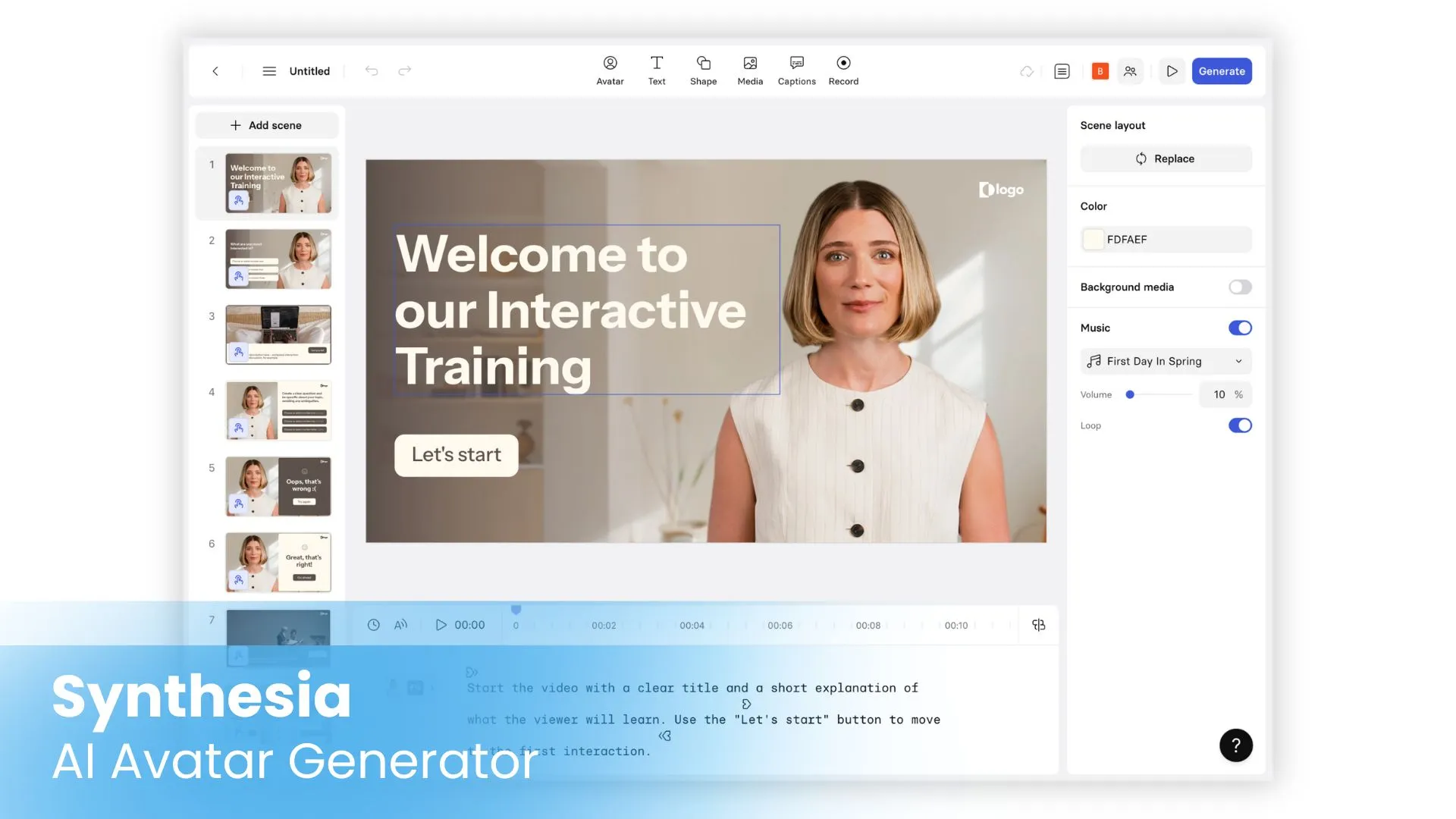
Key Features
- Industry-Leading AI Avatars: Provides access to over 230 ready-made avatars and supports the creation of custom avatars generated from selfies or prompts, all featuring natural expression, eye movement, and accurate multilingual lip sync.
- Long-Form Video Capability: Enables video generation of up to four hours in length—rare among competitors—while maintaining consistent avatars, voices, and presentation quality for extended business use cases like onboarding or product training.
- Script-to-Video Automation: Automatically converts scripts, web pages, PowerPoint slides, or PDFs into finished videos, integrating avatars, subtitles, and branded visuals to streamline production workflows.
- Interactive Elements: The latest version, Synthesia 3.0, introduces interactive “Video Agents” that allow viewers to engage with videos through clickable options, branching scenarios, and in-video Q&A for personalized training and sales applications.
- Translation and Dubbing: One-click translation and dubbing features support over 30 languages, providing native-quality voiceovers with frame-accurate lip synchronization for global distribution.
- Media Integrations: Offers a built-in media library with royalty-free visuals, background music, screen recording, auto-generated captions, voice cloning, and analytics dashboards for engagement tracking.
Strengths
Synthesia stands out for its enterprise scalability and consistency. It’s trusted by major corporations for training, onboarding, and marketing due to its ability to handle high video volumes with uniform quality. Its translation and localization tools enable global communication while maintaining brand accuracy. The platform also provides advanced collaboration features like shared workspaces, version control, and approval workflows. For businesses, Synthesia delivers the polish and reliability of a studio production environment with the efficiency of automated AI tools.
Limitations
While highly capable for professional content, Synthesia’s creative range is limited. Its avatars are optimized for corporate narration rather than cinematic or highly expressive storytelling, resulting in less emotional nuance. The platform’s pricing scales quickly for users producing large volumes or needing custom avatars, with certain features restricted to enterprise plans. Additionally, its moderation systems may occasionally delay publishing for sensitive or non-standard scripts. Despite these constraints, Synthesia remains the benchmark for enterprise-grade AI avatar video production, prioritizing quality, consistency, and scalability over creative experimentation.
4. HeyGen
HeyGen is a fast-growing AI video creation platform designed to make business and marketing video production accessible without cameras, actors, or manual editing. It enables users to create professional videos for training, product demos, and social content using digital avatars, AI voice cloning, and automatic translation. Although it’s easy to use and capable of high-quality results, HeyGen is often slower at synthesizing videos compared to other platforms, especially when rendering longer or high-resolution projects.
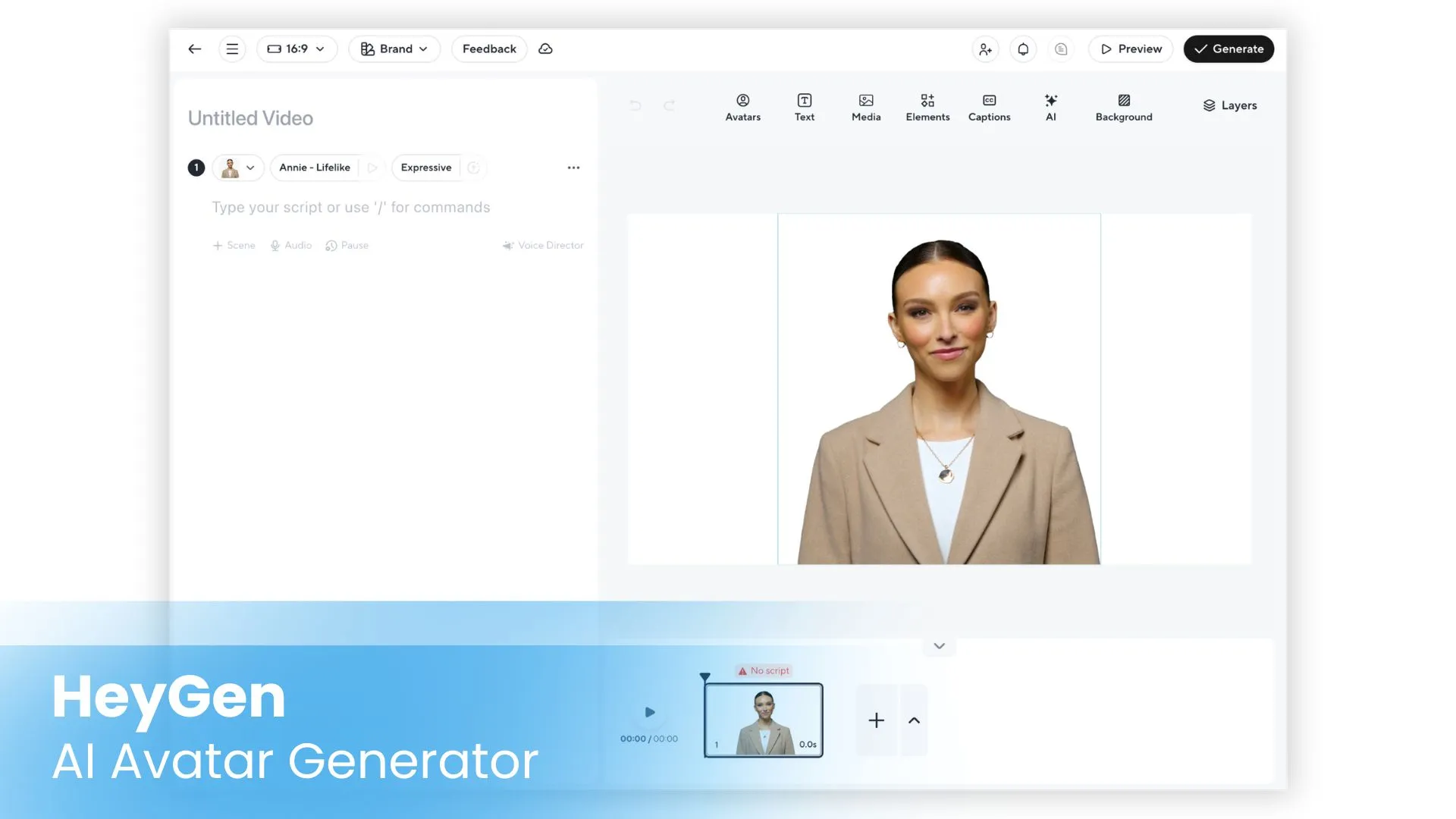
Key Features
- Large Avatar Library with Custom Options: Offers 1000+ digital presenters, along with tools to turn any uploaded photo into a talking-head avatar. Avatars support over 175 languages and dialects, maintaining natural speech rhythm, gestures, and lip sync.
- Voice Cloning and Dubbing: Partners with ElevenLabs and similar providers for realistic voice cloning. Users can clone their own voice, generate multilingual voiceovers, or create dubbed versions of existing videos with precise lip sync.
- Collaboration and Brand Customization: Teams can co-edit projects, leave comments, and add logos or intros for brand consistency across all video assets.
- AI Content Repurposing: Automatically converts long-form videos into short clips or social media formats using smart scene detection and resizing tools.
- Flexible Output: Exports videos in 1080p or 4K, with watermark-free output available for paid subscribers and easy sharing across multiple platforms.
Strengths
HeyGen’s biggest advantages are its user-friendly editor, broad language support, and highly expressive avatars. The avatars feature realistic gestures, facial expressions, and natural pacing, which help create engaging and professional-looking business videos. The interface is intuitive and requires no technical background, making it suitable for marketers, educators, and content teams looking to scale production. Its localization tools are particularly strong, enabling multilingual teams to produce consistent global content quickly and efficiently.
Limitations
HeyGen’s main drawback is speed. Despite its intuitive interface, video rendering and processing times can be noticeably slower than competing platforms, especially for longer clips or complex avatars. Many advanced features, such as voice cloning, custom avatars, and watermark-free exports, are locked behind paid tiers, while free users face strict video duration limits. Additionally, while avatars look polished, their emotional range and spontaneity are still limited, making them less suited for cinematic or storytelling-driven projects. Even so, HeyGen remains a capable tool for professional, training, and marketing videos that prioritize accessibility and multilingual reach over production speed.
4. Runway
Runway combines AI-driven image generation and video editing to create realistic, customizable digital avatars from static photos or short video clips. These avatars can be animated, given speech, and used in a range of projects from professional explainers and social content to experimental films. Unlike presenter-focused tools, Runway’s approach merges creative control with technical flexibility, allowing creators to turn still portraits into dynamic talking avatars through motion transfer and advanced animation tools.
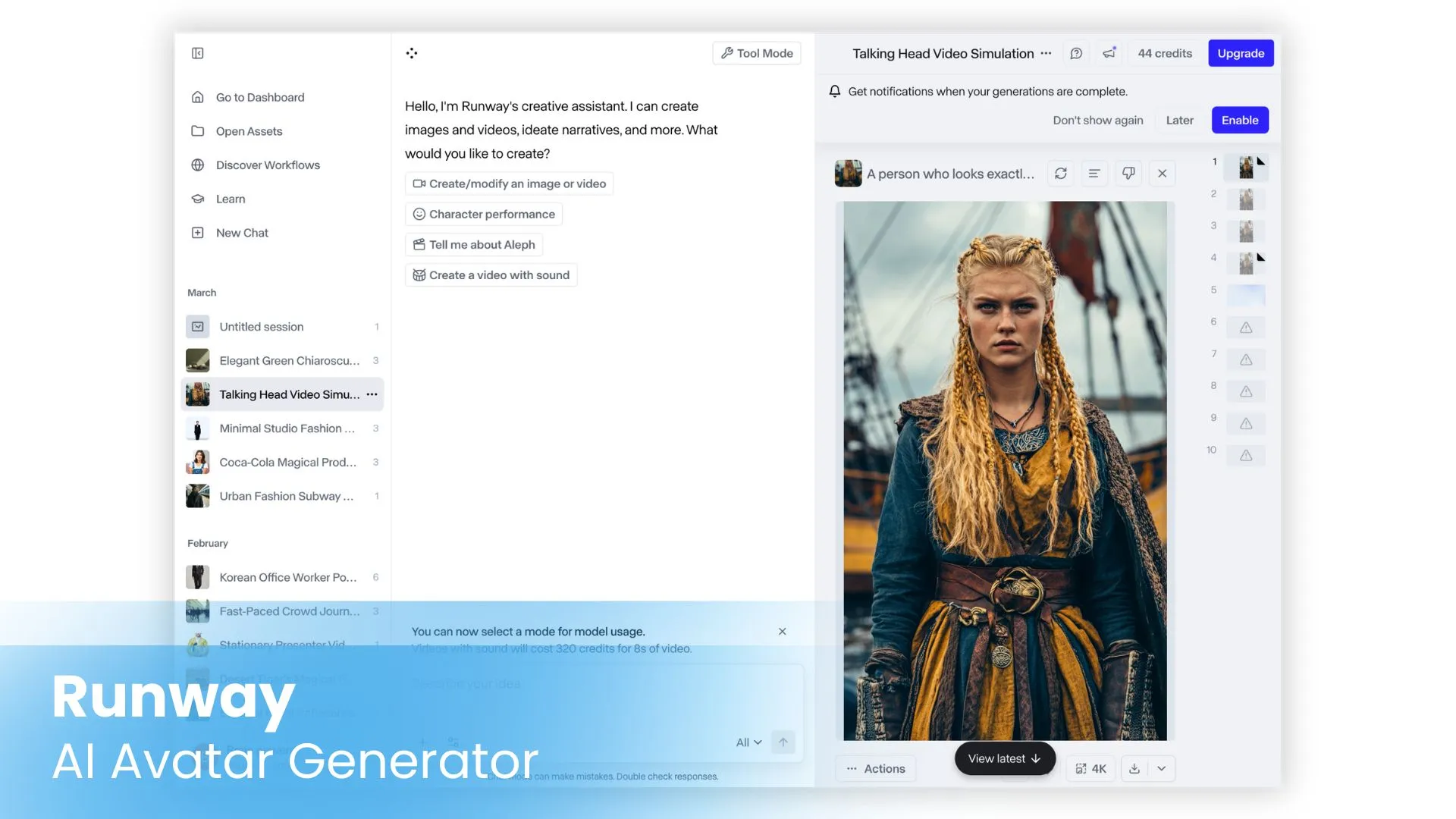
Key Features
- Avatar Creation from Images and Video: Users can upload a single photo or a short video clip, which Runway’s AI transforms into a digital avatar capable of natural motion and speech using motion transfer technology.
- Gen-3 Alpha for Animation: The Gen-3 Alpha model allows static images to be animated into short video clips, adding realistic gestures, synchronized lip movement, and camera controls for a professional finish.
- Custom Character Consistency: The Gen-4 model improves consistency across multiple clips, maintaining the same facial identity, clothing, and expressions to support longer videos or episodic storytelling.
- Motion and Lip Sync: Offers precise lip synchronization and expressive facial animation so avatars can speak scripted text in different languages with accurate timing and tone.
- Avatar Use Cases: Useful for presentations, social media videos, tutorials, and creative filmmaking where animated characters or virtual presenters are desired.
Strengths
Runway’s strength lies in its flexibility and creative control. It allows users to customize avatar expressions, gestures, and camera angles while maintaining consistent character quality across scenes. The platform integrates smoothly with Runway’s broader suite of video and editing tools, making it ideal for creators who want to combine avatars with cinematic or artistic elements. It is particularly well suited for visual experimentation and storytelling that requires style and motion versatility.
Limitations
Runway avatar videos are often limited to short clips of around 10 seconds, requiring manual editing for longer projects. Many advanced features, including higher-quality exports and watermark removal, are only available on paid plans, and free users experience slower rendering speeds. The platform focuses more on animation flexibility than on photorealistic human avatars, so it cannot match the lifelike quality of tools like AI Studios. Avatar expressiveness and background stability are still improving and can occasionally show artifacts, which means some fine-tuning may be needed for professional-quality results.
5. D-ID
D-ID is a generative AI video platform that transforms static photos or short video clips into lifelike talking avatars. It is designed for creators, educators, marketers, and businesses that need to produce videos quickly without cameras or actors. Users can upload an image, provide text or audio, and D-ID’s AI animates the avatar with synchronized lip movement, natural expressions, and realistic voice delivery. The platform also supports video translation, voice cloning, and API integrations that allow avatars to be embedded in apps or automated workflows.
Key Features
- Avatar Creation from Photos or Video: Upload a single portrait or short clip and convert it into a talking avatar with natural facial expressions, gestures, and precise lip sync.
- Video Translation and Localization: Translate existing videos into multiple languages while preserving lip sync accuracy and original tone, making it ideal for global marketing or e-learning.
- Voice Cloning and Custom Audio Uploads: Use your own voice or an uploaded audio file to give avatars a personalized sound and tone.
- Interactive AI Agents and APIs: Build interactive avatars that can respond in real time or be embedded into websites and applications for conversational use.
- Multilingual Output: Supports over 100 languages and dialects with synchronized lip movement for localized content.
- Creative Reality Studio: A browser-based workspace where users can script, generate, and manage videos, with collaboration tools for teams.
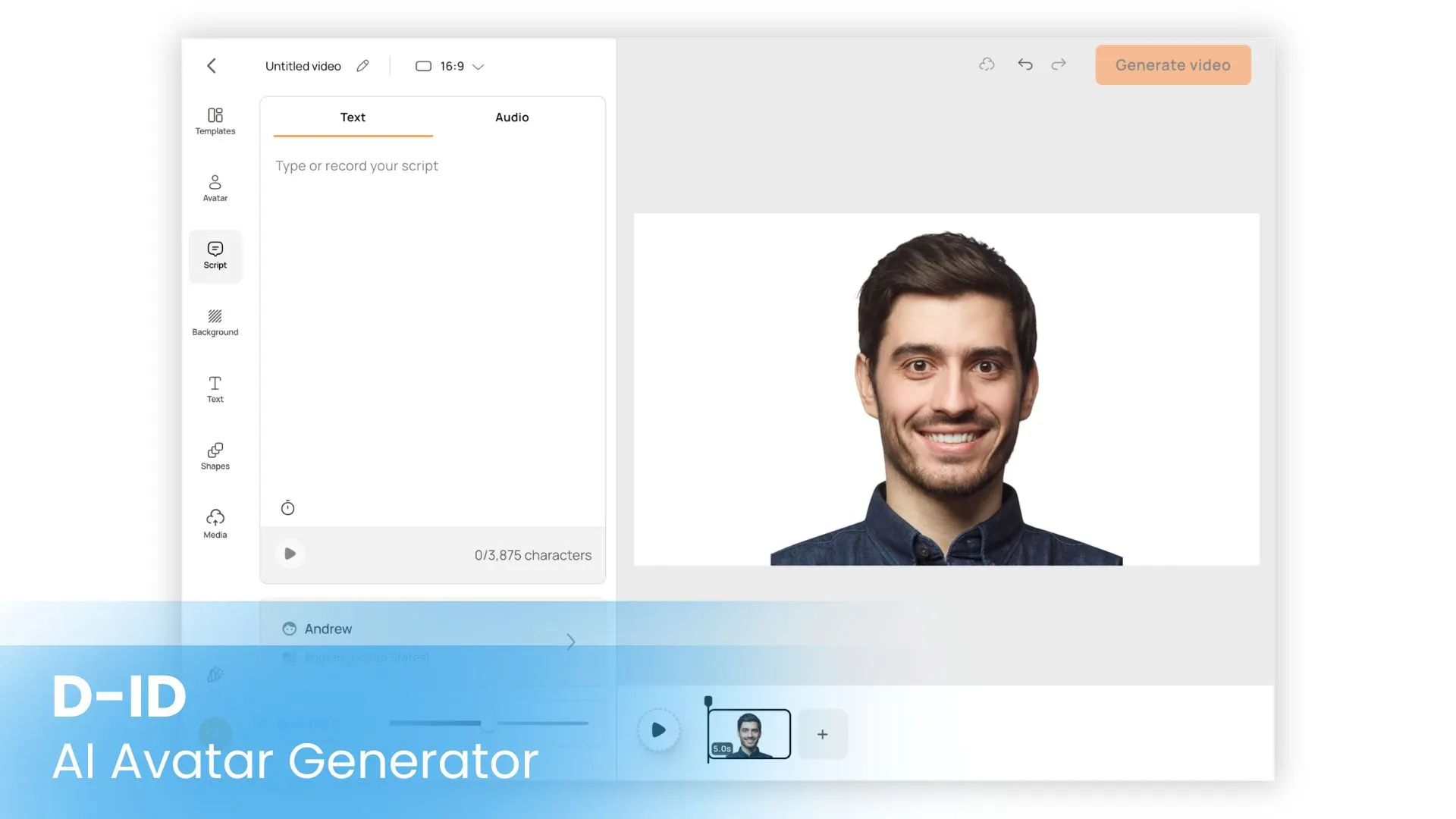
Strengths
D-ID is one of the most refined tools for turning static images into believable, speaking avatars. Its facial animation and lip-sync quality are consistently high, making it excellent for product explainers, learning modules, and marketing videos. The platform’s video translation and localization tools are particularly effective for teams that need to scale multilingual content efficiently. It also offers flexible voice options, interactive avatar features, and developer APIs for integrating into larger pipelines or customer platforms.
Limitations
D-ID’s free plan includes watermarks and limited video durations, which may not suit professional use. Video rendering can take longer for complex avatars or high-resolution exports, especially on busy servers. While its avatars look realistic, they are based on still-image animation rather than fully 3D characters, so complex body motion or emotional nuance can appear limited. More advanced features, such as custom voice cloning and watermark-free exports, are restricted to higher subscription tiers. Despite these limits, D-ID remains one of the most accessible and versatile platforms for quickly generating realistic AI avatar videos.
6. Elai
Elai.io is a browser-based AI video creation platform built for business, education, and marketing use. It allows users to convert scripts, web pages, or presentation slides into narrated videos with digital avatars, voice cloning, and multilingual support, without needing cameras or studios. Its features emphasize scalability, interactivity, and brand consistency, making it suitable for training, internal comms, and content automation.
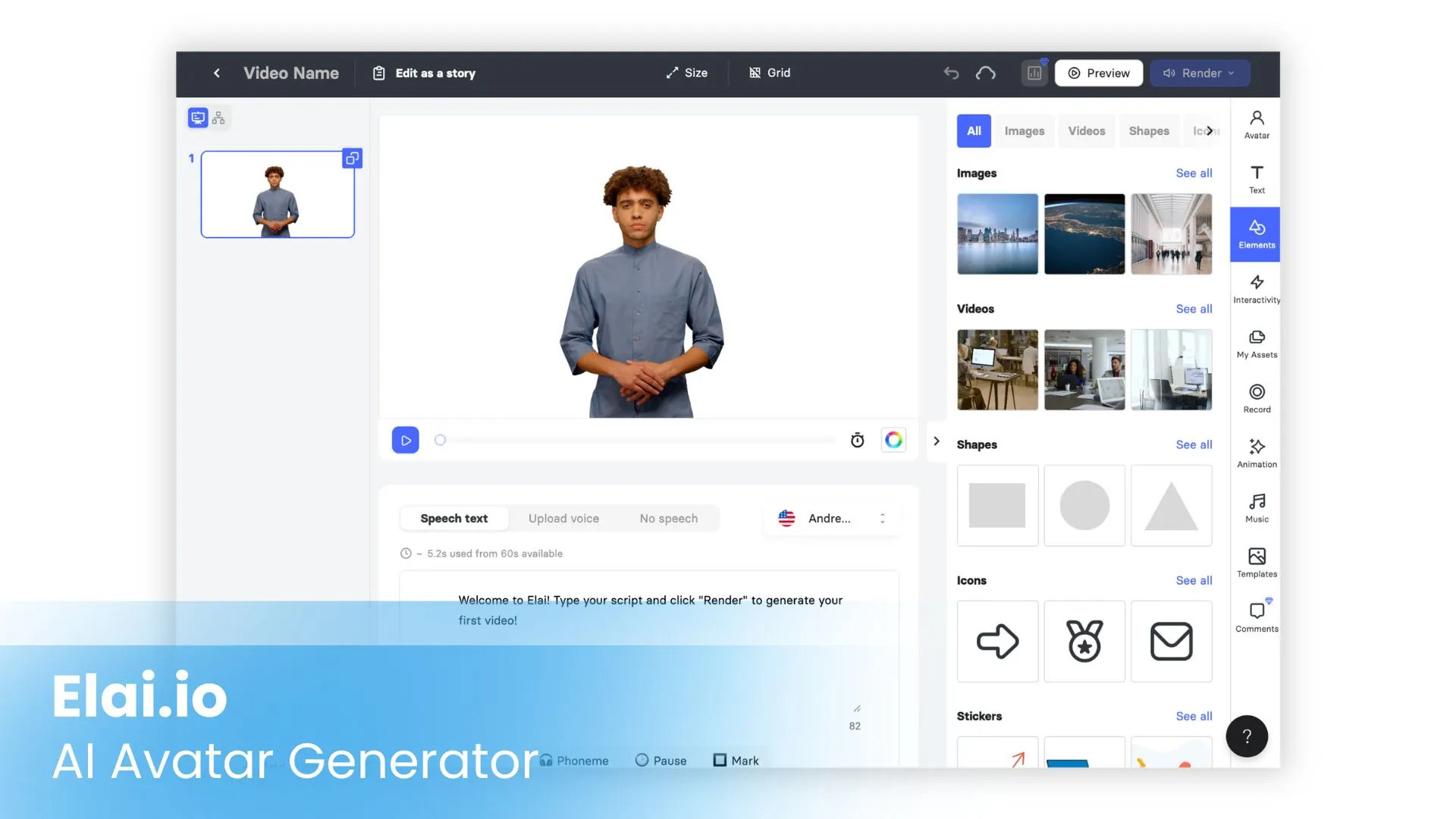
Key Features
- Avatar Library & Custom Avatars: Over 80 avatars included by default, with options for custom selfie or studio avatars.
- Script / URL / Slide to Video: Convert text, blog URLs, PowerPoint, or PDFs directly into video.
- Voice Cloning & Multilingual Support: Supports voice cloning in more than 28 languages and output in 75+ languages.
- Interactive Video Elements: Branching logic, quizzes, hotspots, and clickable buttons.
- Brand & Collaboration Tools: Brand kit (fonts, logos, colors), shared workspace and editing permissions.
- High Quality Output: Exports in Full HD, and higher tiers support Ultra HD / 4K.
- API & Automation: Public API for programmatic video generation and workflow integrations.
- PPTX & Screen Recording Support: Import slides or add screen recording segments into videos.
Strengths
Elai.io is especially effective at automating video production at scale. It speeds up turning text or slide content into polished avatar videos, reducing reliance on filming or editing tools. The interactive features make it valuable for learning and development or internal training. Its localization, voice cloning, and brandkit tools help users maintain consistency across languages and create on-brand content globally. The API and automation support help businesses embed video generation into their workflows.
Limitations
Free plans come with tight limits (e.g. 1 minute, watermarking) and many premium features (custom avatars, voice cloning, 4K exports) are locked behind paid plans. Rendering times can be long for complex videos or during peak usage. Avatars, while good, sometimes show less fluid motion or emotion in more dynamic scenes. The template / automation style limits deep control for cinematic or highly custom creative work. Finally, unused video minutes typically don’t roll over, so you must plan usage carefully.
7. Colossyan
Colossyan is an AI avatar generator and AI video maker that transforms text, documents, and slides into professional, presenter-led videos. It is designed primarily for training, internal communication, and e-learning, allowing teams to create engaging, multilingual video content without cameras or complex editing. The platform’s focus on ease of use, interactivity, and collaboration makes it one of the most accessible tools for organizations that want to scale video production efficiently.
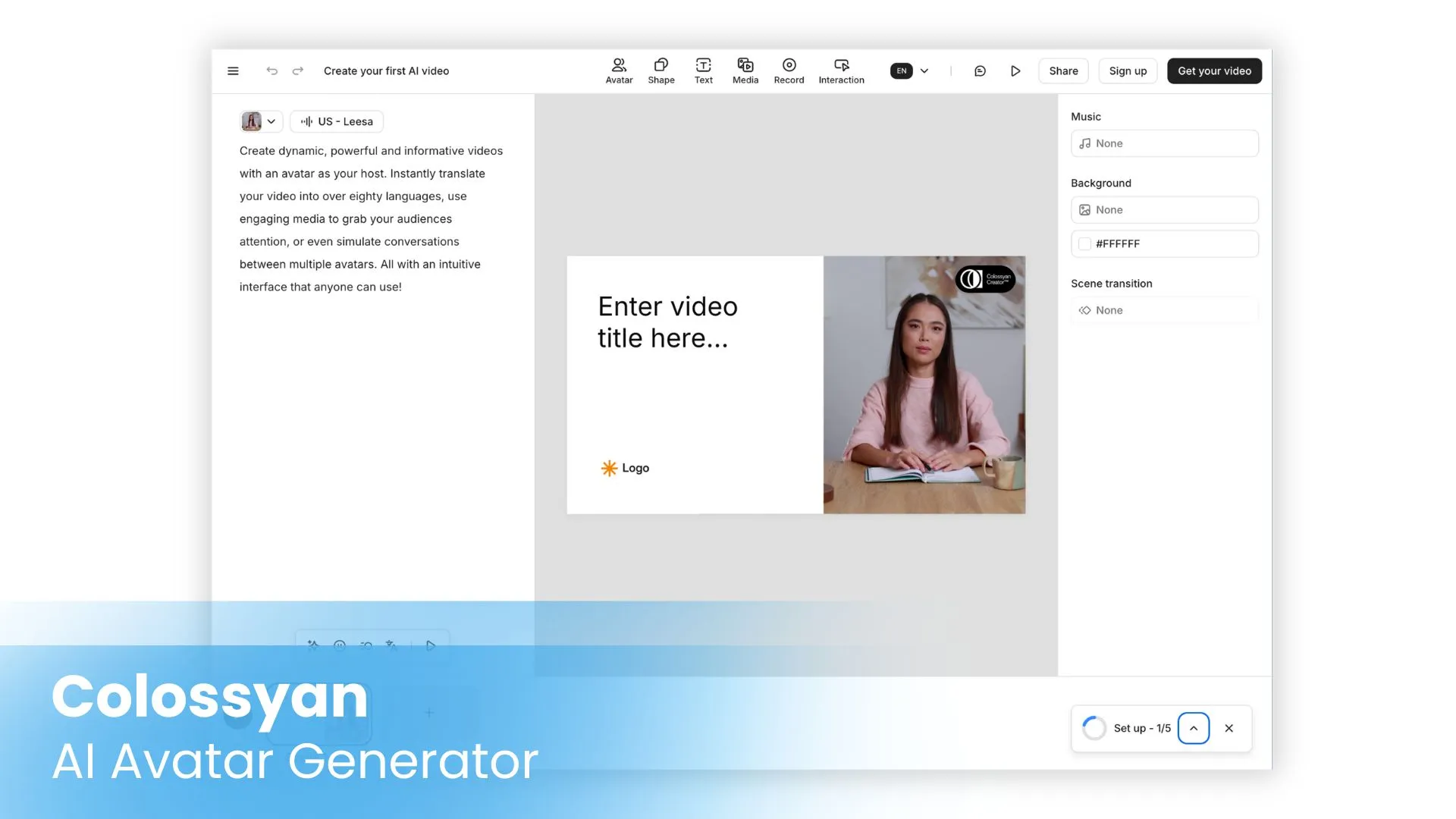
Key Features
- AI Avatar Generator and Custom Avatars: Offers a growing library of over 150 avatars, with options to create a custom avatar from a short recording for a personalized video presenter.
- Text-to-Video Conversion: Instantly turns written text, PowerPoint slides, or scripts into videos featuring AI avatars that deliver content naturally with synchronized speech and gestures.
- Multilingual Translation and Localization: Supports more than 70 languages, automatically translating both voice and subtitles for global content creation.
- Multi-Avatar and Conversation Scenes: Allows multiple avatars to appear in one video, creating interactive dialogues or simulated interviews for a more dynamic presentation.
- Interactive Video Features: Add quizzes, branching scenarios, and clickable responses to make videos more engaging and suitable for learning and development.
- Brand and Template Management: Includes a brand kit for fonts, logos, and colors, plus predesigned templates for quick, consistent video creation.
- Collaboration and Workflow Tools: Enables shared editing, team feedback, and approval workflows. API access and SCORM export support integration into enterprise workflows and LMS systems.
Strengths
Colossyan’s biggest strength is its ability to simplify professional video creation at scale. As an AI avatar maker, it helps teams create high-quality, realistic training videos in minutes instead of days. Its automatic translation and localization tools make it ideal for multinational teams, while its interactivity options help maintain viewer engagement and retention. The ability to use multiple avatars per video also adds narrative variety that many competitors lack. For organizations that need fast, on-brand, and multilingual communication, Colossyan offers one of the most balanced solutions in the AI avatar market.
Limitations
While Colossyan’s AI avatars are clear and professional, they can appear slightly less expressive than avatars from higher-end platforms focused on cinematic realism. Some premium features such as custom avatars, 4K rendering, and advanced integrations are limited to paid plans. Longer or more complex videos can take time to render, and deep animation or fine emotional detail remains relatively basic. However, for most business, training, and educational applications, Colossyan delivers excellent value as a practical and reliable AI avatar generator that prioritizes accessibility, scalability, and performance.
8. DreamFace
DreamFace is an AI avatar generator and video creation platform that lets users transform photos or short video clips into speaking avatars and animated content. The core idea is to make avatar video production accessible—upload a photo or clip, add text or audio, and let the tool bring it to life with lip sync, expressions, and voice.
Key Features
- Avatar Video from Images / Clips: You can upload a static image or short video and convert it into a talking avatar with natural lip movements and facial expressions.
- Dream Avatar 3.0 Full-Body Animation: The platform supports full-body avatar generation from images, not just talking heads, enabling more dynamic motion in videos.
- Custom Voice & Audio Input: Users can supply their own text or audio script that the avatar will speak, with selectable voice styles.
- Multilingual & Localization Support: DreamFace supports multiple languages, allowing creators to reach diverse audiences.
- Templates & Themed Animations: The tool includes various visual effects and templates (for actions like hugs, flying, or stylized filters) to enhance creative output.
- Platform Availability: DreamFace works via web, mobile (iOS & Android), and offers cross-platform accessibility for creators.
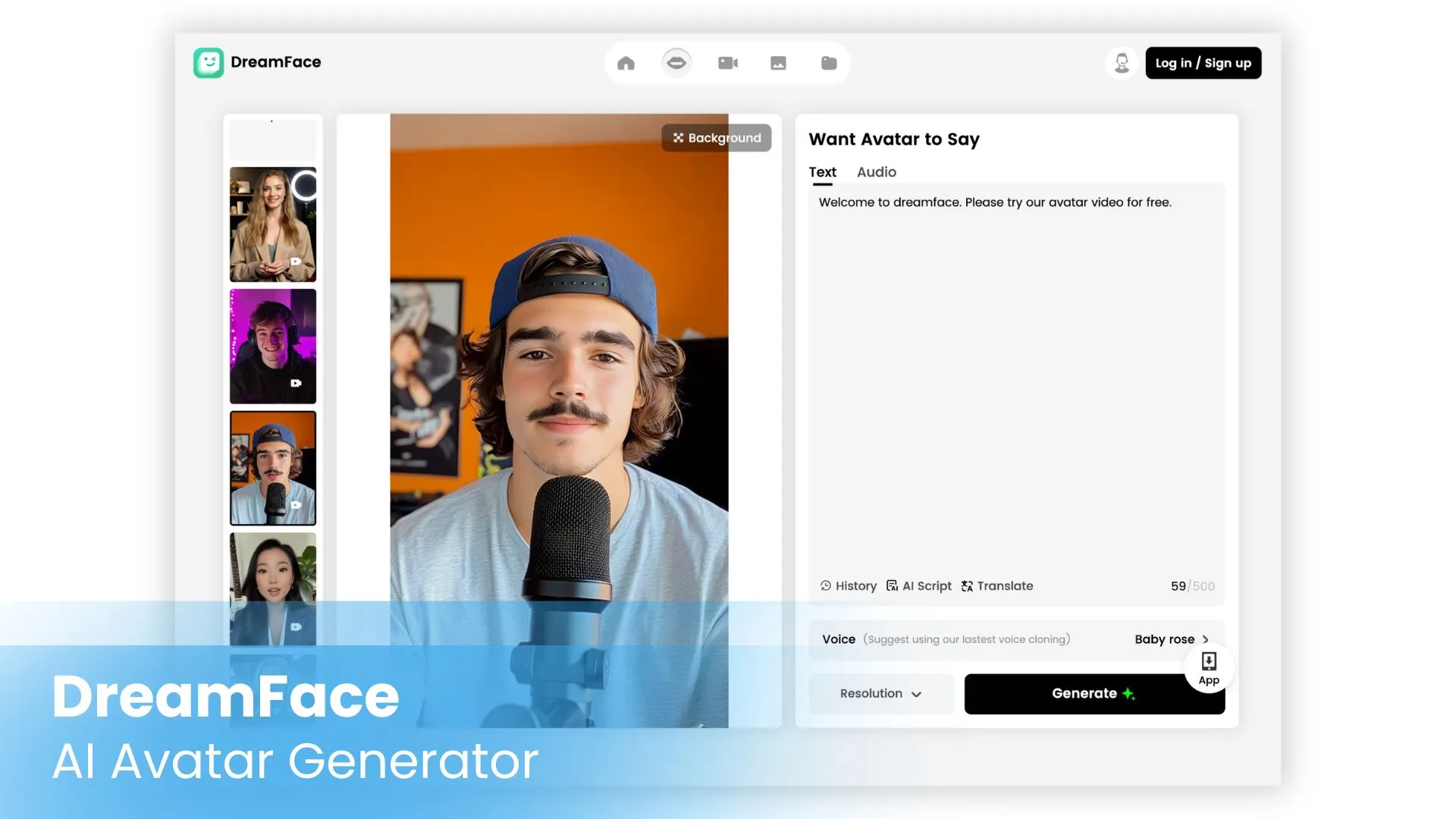
Strengths
DreamFace is intuitive and quick—ideal for users who need fast avatar video generation without deep technical experience. Its full-body animation capability sets it apart from many avatar tools that only handle head or face motion. The variety of animation styles and themed templates make it fun and flexible for social media content. Its cross-platform support means you can create on desktop or mobile seamlessly.
Limitations
Because DreamFace focuses on image-to-video conversion, very complex body movement or interactions with dynamic environments can lead to visual artifacts. The quality and realism of expressions are less refined than platforms focused solely on photorealistic avatars. Some advanced features and high-quality rendering may require premium plans. Also, video duration and fidelity may be limited in free or lower-tier versions.
9. Mango AI (Mango Animate)
Mango AI is an online AI video platform that turns text, images, and scripts into talking avatar videos. As an AI avatar maker, it allows users to upload portrait photos or short clips, then generate video content where those avatars speak with natural lip sync, expressions, and voice. It also includes features such as face swap, avatar customization, and template-based video generation for business, educational, or social content.
Key Features
- AI Avatar Generator & Talking Head Videos: Upload a portrait photo or choose from premade avatars to generate a video in which the avatar speaks your script with synchronized lip motion and expressions.
- Text / Image / Script to Video: Create avatar videos from scripts, images, or text inputs. The tool supports turning still images into talking avatars or combining images and scripts into video scenes.
- Voice & Language Support: Uses AI voices for narration; supports multiple languages and voice options (120+ voices or languages in some instances).
- Custom Avatar Creation: Users can upload short videos to create a custom avatar (“digital twin”) which more closely mimics their face and voice patterns.
- Face Swap & Photo Animations: Swap faces in videos, animate photos (so static images seem alive), and use templates to simplify video creation.
- Templates & Video Effects: Provides templates for explainer videos, training content, marketing promos, with background, style, and transition options.
- Export & Sharing: Ability to download or share completed videos; in free plans avatars or videos may have watermarks or lower resolution.
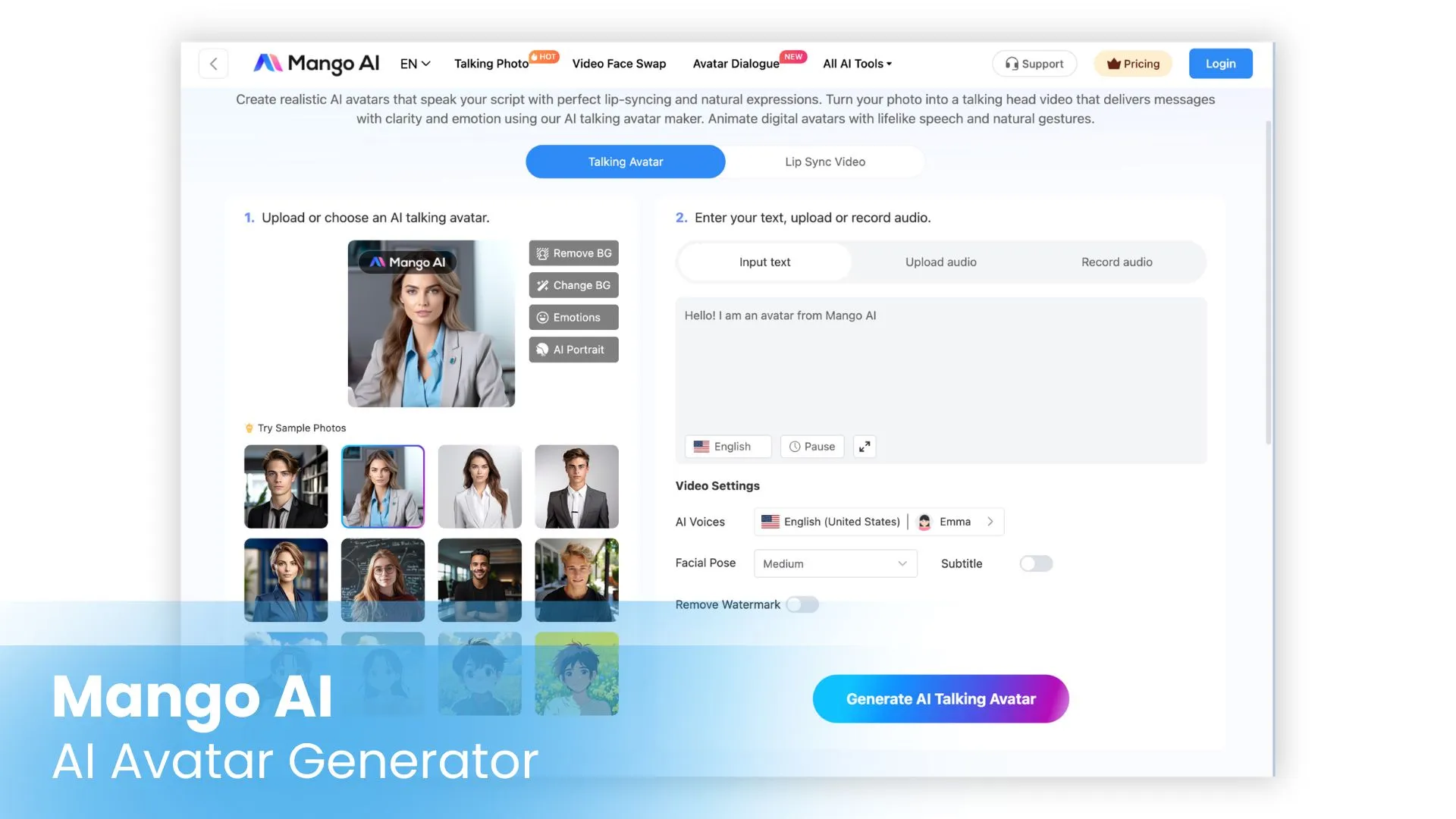
Strengths
Mango AI offers a highly accessible way to generate avatar videos quickly. Its strength lies in converting static images into talking, expressive avatars without needing video shoots. The custom avatar creation lets users get closer to lifelike avatars by uploading their own clips. Face swap and photo animation features add versatility for creative use cases. Templates and a guided workflow lower the barrier to creating polished content. For educational, marketing, or social media content that needs a quick avatar video, Mango AI is a practical and user-friendly choice.
Limitations
At lower or free tiers, output is often limited in resolution and may include watermarks, reducing usability for professional presentation. Rendering and processing complex videos or custom avatar data can be slow. Because the system converts from images rather than full 3D models, movements, gestures, and emotional nuance can be less fluid or detailed compared to more advanced avatar platforms. The depth of control over avatar animation, background interaction, or cinematic motion is also constrained. For high-end productions or deeply expressive character work, Mango AI might not match more specialized tools, but it offers strong value for many everyday avatar video needs.
10. Typecast
Typecast is an AI-powered content creation platform focused on generating realistic voices and expressive avatars. While best known as a text-to-speech tool, it also includes a talking avatar generator that lets users pair lifelike voices with facially animated characters. Typecast is widely used by content creators, educators, and marketers to produce voiceovers, video narrations, and short avatar-led clips without the need for recording equipment or professional voice actors.
Key Features
- AI Voice Generation: Converts text into expressive, high-quality speech with adjustable tone, pacing, and emotion to match different content styles.
- Talking Avatars: Allows users to create short video clips where an AI avatar lip-syncs to the generated voice, adding personality and realism to content.
- Voice Cloning and Custom Voices: Users can clone their own voices or create unique synthetic ones for consistent branding and character identity.
- Multilingual Support and Dubbing: Offers voice generation and dubbing in multiple languages, allowing creators to reach a global audience.
- Emotion and Tone Control: Users can modify emotion, energy, and delivery style to produce natural, nuanced performances for narration or dialogue.
- Voice and Avatar Library: Includes a wide range of voice and avatar styles, from professional narrators to casual or character-based tones.
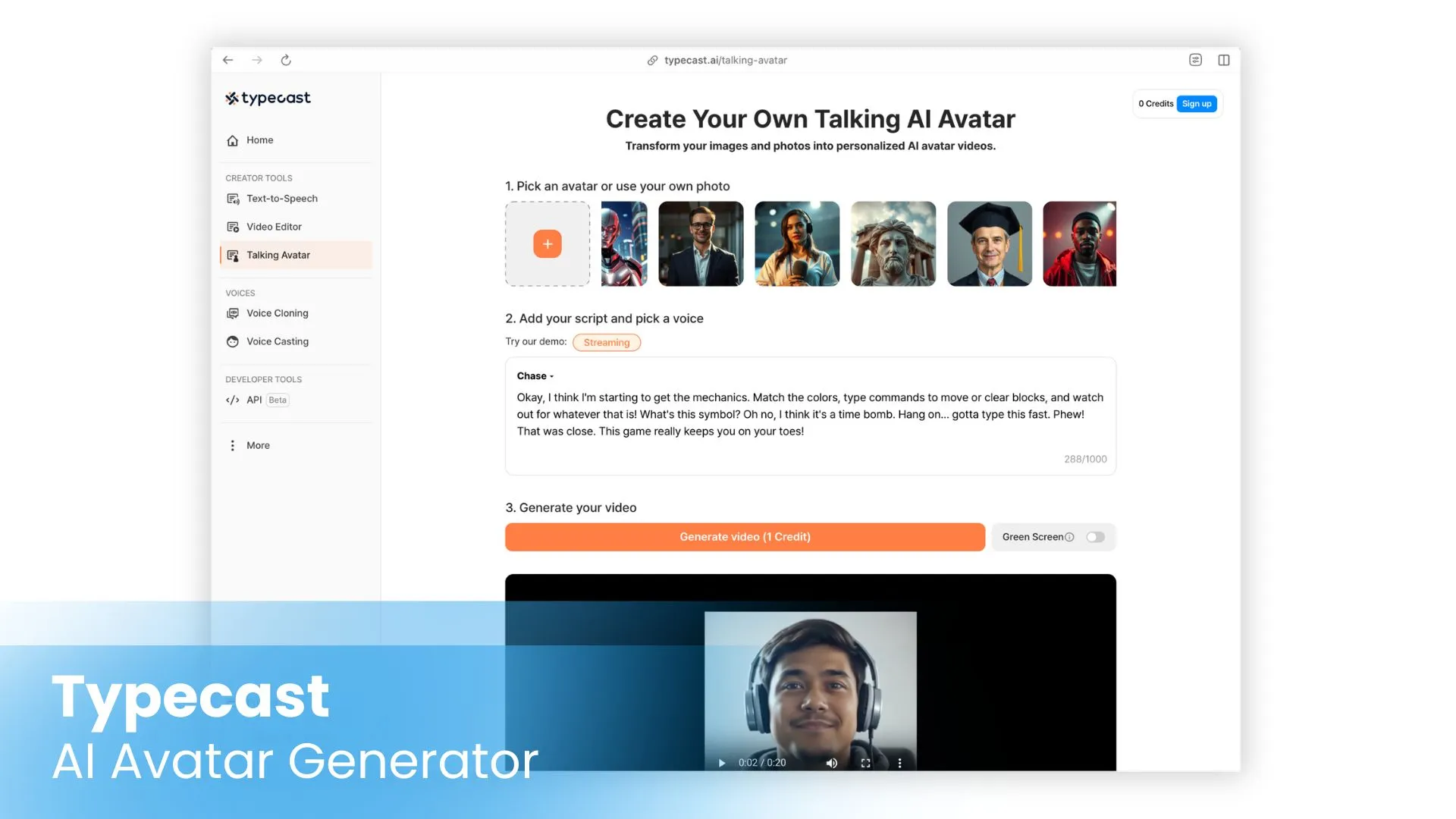
Strengths
Typecast’s biggest strength is its voice realism. The platform produces natural, emotionally varied voices that stand out among AI generators. Its avatar system complements this strength by letting users pair the voices with visual faces, ideal for creating explainer videos, educational lessons, and product announcements. Typecast’s emotional tone control helps users fine-tune delivery, making it suitable for both corporate and creative use. It’s also highly accessible for beginners, thanks to its simple interface and cloud-based workflow.
Limitations
Typecast’s avatars are primarily focused on facial animation and lack full-body motion, limiting its use for cinematic or physically dynamic scenes. While it supports multilingual output, emotional nuance can vary depending on the selected voice or language. Rendering times are generally quick but can slow down with longer scripts or higher-quality exports. Some advanced features like custom voice cloning and extended export limits are available only in paid plans. Overall, Typecast is an excellent AI avatar maker for realistic voice-driven content, though it’s best suited for short, speech-focused videos rather than complex animation projects.
How to Choose the Best AI Avatar Generator
With so many options available, the right AI avatar generator depends on your goals, budget, and use case. Here are a few things to look for when making your choice:
- Features and Capabilities: Check whether the platform offers what you need, such as script-to-speech, multilingual voices, customization options, or interactive avatars.
- Avatar Styles: Decide if you want photorealistic avatars, cartoon-style characters, 3D models, or product-integrated avatars. Different platforms specialize in different styles.
- Ease of Use: Some platforms are simple drag-and-drop tools while others require more technical skills. Choose one that matches your comfort level.
- Integration Options: Look at how well the tool works with your existing workflow. Many generators integrate with video editors, e-learning platforms, or presentation software.
- Pricing and Scalability: Costs vary from affordable personal plans to enterprise-level solutions. Make sure the pricing matches your budget and that the platform can scale as your needs grow.
- Output Quality: Test the voice quality, lip-sync accuracy, and movement of the avatars. The best platforms produce natural, engaging results that don’t feel robotic.
- Support and Updates: Choose a tool backed by strong customer support and regular updates so you benefit from the latest improvements in AI technology.
AI Avatar Generator Frequently Asked Questions
Can AI avatars be customized to match a brand’s identity?
Yes, AI avatars can absolutely be customized to match a brand’s identity, and that’s one of the biggest advantages of using an AI avatar maker or AI avatar generator today. Instead of relying on generic digital presenters, brands can now create avatars that look, sound, and act like part of their team. You can choose how your avatar looks—from hairstyle and outfit to facial features and expressions—so it fits your company’s overall tone and visual style.
Many AI avatar generators also let you clone voices, pick custom accents, and adjust personality traits to match your brand’s communication style. For example, a tech company might choose a confident, professional avatar with a calm tone, while a lifestyle brand could design a more casual, upbeat digital host. You can also add branded backgrounds, logos, and on-screen elements to make videos feel cohesive across marketing, training, and social platforms.
What’s great is that once you’ve built a custom avatar, you can use it again and again across projects. That means every video you create—whether it’s a product demo, onboarding tutorial, or global announcement—maintains the same look and feel. It’s a simple, scalable way to keep your brand consistent while saving time and production costs. In short, modern AI avatar makers make it easy for any company to have a digital face that truly represents who they are.
Do AI-generated avatars support multiple languages?
Yes, most modern AI avatar generators and AI avatar makers support multiple languages, making them ideal for global communication. These platforms use advanced text-to-speech and lip-sync technology so that AI avatars can speak naturally in more than a hundred languages and regional accents. The avatars not only change the voice but also adjust lip movements and facial expressions to match the spoken language, creating a realistic and localized experience.
For example, you can write a script in English, translate it into Japanese or Spanish, and your avatar will deliver it with accurate pronunciation and natural mouth movement. Many tools also let you choose specific accents or adjust tone and pacing to sound authentic to each audience. This makes it much easier for teams to produce videos for marketing, education, and training that resonate across different regions.
Platforms like AI Studios, which is designed for both business and creative projects, make this process simple. You can create professional explainer videos, tutorials, or storytelling content in multiple languages using the same avatar and consistent branding. Multilingual support helps ensure that every message feels local, clear, and authentic, no matter where your audience is in the world.
Can I reuse or update my avatar across videos without re-recording?
Yes, you can absolutely reuse and update your AI avatar across multiple videos without having to re-record anything. That’s one of the biggest advantages of using an AI avatar generator or AI avatar maker. Once you create or upload your custom avatar, it’s saved in the platform’s library and can be used again anytime by simply typing a new script or uploading updated content.
Most platforms, including AI Studios, Colossyan, and Synthesia, make it easy to manage and update avatars as your projects evolve. You can reuse the same avatar for new videos, change the voice, language, outfit, or background, and even adjust the tone or delivery to fit different types of content. This means your avatar can serve as a consistent brand spokesperson or digital character that grows with your messaging over time.
If your brand or product visuals change, you can also refresh your avatar’s appearance or voice without starting from scratch. For example, many platforms allow you to update clothing to match new branding, or use voice cloning to fine-tune your avatar’s speech for a new tone or region. This flexibility saves a significant amount of time and cost while keeping your content consistent and up to date. In short, a high-quality AI avatar maker lets you treat your digital presenter like a long-term brand asset that can easily evolve across every video you create.
What is an AI Avatar?
An AI avatar is a digital character created using artificial intelligence that can speak, move, and express emotions like a real person. These avatars are generated and animated through advanced AI models that combine computer vision, speech synthesis, and motion tracking. They can deliver scripted dialogue, mimic facial expressions, and even respond in real time, depending on the platform.
Modern AI avatar generators and AI avatar makers allow users to create these avatars from photos, videos, or 3D models. You can choose a pre-designed avatar or upload your own image to turn it into a lifelike digital presenter. The avatar then uses AI to animate facial features and sync lip movement to recorded or generated voices, creating the illusion of natural speech and personality.
AI avatars are used in many industries for different purposes. Businesses use them for training, marketing, and corporate communication. Educators use them to create engaging lessons, while creators use them to produce videos, games, or interactive experiences without the need for filming. In short, an AI avatar is a smart, customizable digital human that helps people communicate and create content more efficiently and consistently.
What’s the difference between a photo avatar and a video-based avatar?
A photo avatar is generated from a single image. You upload a clear photo of a person, and an AI avatar maker or AI avatar generator brings it to life by animating facial movements, expressions, and lip sync. This type of avatar is fast and easy to make, which makes it ideal for quick projects, social content, or when you need a simple talking presenter. However, since it’s built from a still image, motion can look more limited and less dynamic.
A video-based avatar, on the other hand, is created from actual video footage of a real person speaking and moving. The AI avatar generator uses this footage to learn that person’s natural expressions, gestures, and speech patterns, resulting in a far more lifelike and expressive digital presenter. Video-based avatars usually have smoother motion, more emotional range, and better realism, making them the preferred choice for business, training, or marketing content that needs a professional and polished look.
In short, photo avatars are quick and flexible, while video-based avatars are higher quality and more realistic. The right choice depends on your goals—photo avatars are great for speed and experimentation, and video-based avatars are best when you want natural human presence and detail.
Who owns the rights to an AI avatar I create?
Ownership of an AI avatar depends on whether you are using a stock avatar or a custom avatar. In AI Studios, both options come with clear usage rights and strong data protection policies.
All stock avatars in AI Studios are completely copyright free. Users can include them in any type of video project, whether it is commercial, educational, or internal, without worrying about copyright claims or extra licensing fees. These avatars are available for all users on the platform and are created specifically to be used freely in professional and public-facing content.
Custom avatars in AI Studios are treated with full privacy and exclusivity. When a user creates a custom avatar from their own video or image, that avatar is stored securely and linked only to that user’s account. It cannot be accessed, edited, or viewed by anyone else, including AI Studios staff. The data and likeness are kept private and are not shared across the platform. This ensures that every custom avatar is fully exclusive to its creator and protected from unauthorized use.

